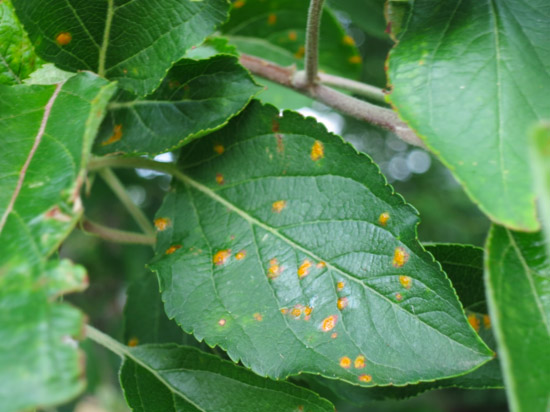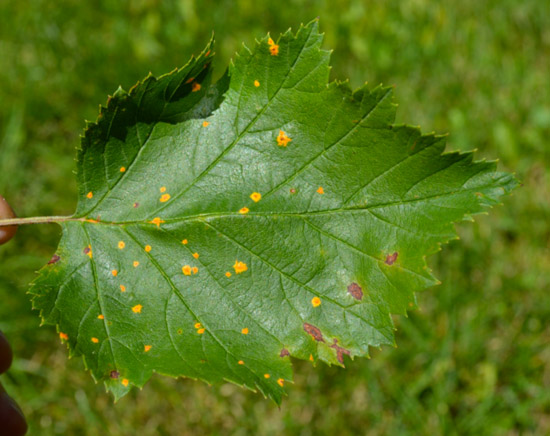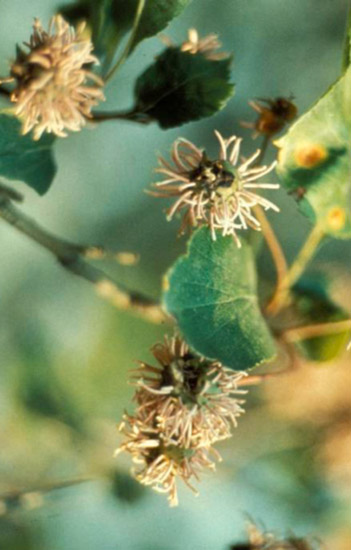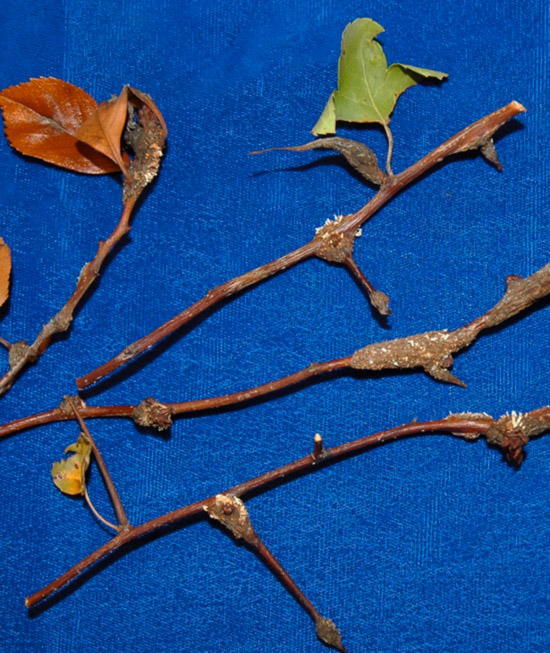Issue 7, June 10, 2013
Common Cedar Rust Disease of Illinois
There are three common rust diseases found in the landscape that use cedar (Juniperus spp.) as an alternate host:
- Cedar-apple rust (Gymnosporangium juniperi-virginianae)
- Cedar-hawthorn rust (Gymnosporangium globosum)
- Cedar-quince rust (Gymnosporangium clavipes)
In Illinois, Cedar-apple rust is the most common of the above three. Infections can occur on leaves, fruits and twigs of apples and crabapples. For ornamental trees, leaf symptoms are more of a problem than affected stems and fruits. Leaf symptoms first appear in May and June as pale yellow spots on the upper leaf surface. The spots eventually enlarge and turn orange in color. They will also begin to appear on the underside of the leaf eventually forming tube-like structures (aceia). Infections may result in yellowing leaves and defoliation.

Cedar-apple rust on Malus sp.
Cedar-hawthorn rust can infect several species within the rose family and can cause similar foliar symptoms to cedar-apple rust. The pathogen is considered minor on apple, crabapple, serviceberry and pears. However, the pathogen can cause severe disease on certain hawthorn species (Crataegus spp.). The downy hawthorn (C. mollis) is considered very susceptible to this disease, while infections seem to be less severe on hawthorn species with glossy leaf surfaces (C. crusgalli, C.viridis ‘Winter King'). This rust disease most often affects leaves, causing yellow spots that enlarge eventually and develop a gray-brown color. Severely infected hawthorn leaves often turn bright yellow before dropping prematurely. This pathogen can also damage fruits and twigs. However, this type of damage is more often caused by Cedar-quince rust.

Cedar-hawthorn rust on Downy Hawthorn (Crataegus mollis).
Cedar-quince rust will also infect various members of the rose family. Serviceberry, chokeberry, quince, hawthorn, and apple are some of the more noteworthy hosts. Leaf symptoms for this disease are limited to infections of petioles and veins. This pathogen causes noticeable damage to stems, thorns and fruits of susceptible species. Stems and thorns may become enlarged and deformed. Infected fruit may be covered with fungal aecia, giving them a striking, orange, fringed appearance.

Cedar-quince rust on hawthorn. Fruit Infection.

Cedar-quince rust on hawthorn. Stem and thorn infections. Photo Credit: Nancy Pataky.
Control
Both juniper and hawthorn are necessary for these diseases to occur. Removing any unwanted junipers from landscape, or at least the infected juniper branches may help reduce the occurrence of the disease. However, it may not be a practical management tool to separate the hawthorns from their alternate host (junipers), since spores may still blow in from nearby or neighboring properties. Protection with fungicides is an option that may be considered if these rusts are problems on specimen or high-value trees. Fungicides should be applied in the spring to protect new growth and developing fruit. (Travis Cleveland)
Author:
Travis Cleveland